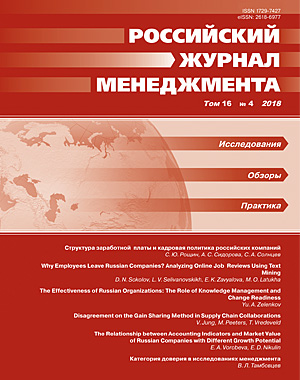The Effectiveness of Russian Organizations: The Role of Knowledge Management and Change Readiness
DOI:
https://doi.org/10.21638/spbu18.2018.403Abstract
Many researchers believe that knowledge is the most important resource in the contemporary economy, but empirical studies show that knowledge management is not among the most used managerial tools. This gap can be explained with the hypothesis that knowledge management produces the significant impact on the effectiveness of organization only with the accompanying development of change management. Herewith the critical element of change management is a change readiness that allows to assess the possibility and feasibility of changes, consolidate and focus efforts, assess the adequacy of resources. This hypothesis is empirically tested using the partial least squares structural equation modeling (PLS-SEM) method on data for 103 Russian organizations. The results show that the empirical sample includes two statistically different datasets. The separating variable is the type of owner, so separate models were built for state-owned and private-owned organizations. For privateowned organizations, the hypothesis that knowledge management and changes readiness jointly affect effectiveness is fully confirmed. For state-owned organizations, knowledge management is not a factor of effectiveness. These results have two practical implications. First, managers who rely on the organizational knowledge should focus on the joint and coordinated implementation of knowledge management and change management. Special attention should be paid to the organizational context that supports individual change readiness. Second, state-owned organizations in Russia are less effective rather private ones, it is due to the fact that knowledge management for them is not the factor of effectiveness, that is in its turn a consequence of suppression of initiatives at the individual level.
Keywords:
knowledge management, change management, change readiness, effectiveness of organization, private-owned organizations, state-owned organizations
Downloads
References
REFERENCES
Downloads
Published
How to Cite
Issue
Section
License
Articles of the Russian Management Journal are open access distributed under the terms of the License Agreement with Saint Petersburg State University, which permits to the authors unrestricted distribution and self-archiving free of charge.





